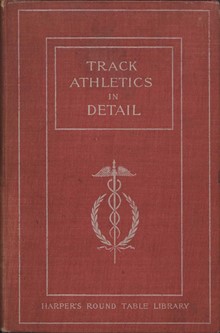A website dedicated to athletics literature / Track Athletics in Detail (extract)
Track Athletics in Detail (extract)
Albert Lee; "Track Athletics in Detail", 1896
Introduction, pp. v-vi.
Track Events, pp. 3-46.
Field Events, pp. 49-98.
Appendix Rules and Records, pp. 139-147.
Author:
The title page states that the book was ‘compiled’ by The Editor of “Interscholastic Sport”, in “Harper’s Round Table”, and we know that to be Albert Lee. Albert Lee was a writer of historical adventures, novels, and children’s stories. It is not known how much, if any, of this book was written by him, nor is it known who the other contributors might have been. We do know, however, who was given credit for some of the photographs.
Photographs:
Credit is given to the following, for some of the photographs -
A series of 3 to B.J. Wefers,
A series of 3 to T.E. Burke,
A series of 8 to E.H. Cady
A series of 6 to J.D. Philips
A series of 8 to S.A.W. Baltazzi.
A series of 6 to R.J. Lyons.
A series of 4 to W.O. Hickok,
A series of 8 to W.O. Hickok.
However, these were the athletes in the photographs, and so it seems that the credit they get is because they agreed to them being used, not because they were the photographers. Other photographs are uncredited.
The importance of Lee’s, “Track Athletics in Detail” in the history of Athletics literature.
The New York Athletics Club’s overwhelming defeat on the London Athletics club in a head-to-head track and field on Manhattan Field in September 1895 was the stimulus for this book. Of the 11 events (6 track, 4 field, and 1 walking event), NYAC won all 11, and set US records in 8 of them, and world records in four. Never has victory been so complete. A wave of local and national pride and admiration followed this victory, and Harper’s published this book to show-case the skill and fitness of these great American athletes. This is not intended for the layman or those with just a general interest; it was written to give the latest information on elite training and technique to young Americans who might otherwise not have access to it. To do so, the book provides the latest photographs of athletes in action, and in eight cases, rapid sequence photographs illustrating the techniques of the champions in the sprints, high-hurdles, 1-mile walk, long jump, pole vault, shot putt, and hammer throw.
In addition, this meeting provided inspiration not only to the male athletes of the USA but to women also. Seven weeks after the NYAC’s victory, Vassar College put on its first Field Day with the events taken from the programme of the NYAC/LAC’s match, and so was launched the world’s first women’s annual athletics competition.
The text.
There are chapters on – the sprints, the middle distances, the mile run, the hurdles, the mile walk, the running high jump, the running broad jump, throwing the hammer, putting the shot and the pole vault. All are well illustrated, some outstandingly so. The text gives some idea of the sense of complete superiority the Americans had, and in one case shows just how stunned the British athletes and officials were. The Britons had expected to do well, and were so taken by surprise by the American’s superiority in every department, they could barely believe it. The text describes how amazed the LAC athletes and officials were at Sweeney’s 6ft 5 5/8 inches world record high jump, and at first could not believe it, and p. 55 shows a photograph of the British contingent measuring the bar themselves before they could be convinced. In the chapter on throwing the hammer an account is given of the Irish and Scottish methods of throwing and how the Irish method finally prevailed in the USA.
Appendices give extracts from the Athletic Rules of the AAU, and a list of Intercollegiate Records, American Amateur Records, and Interscholastic Records, all as on the 1st May 1896.
Peter Radford
Bibliographic details:
Title:
Track Athletics in Detail
Extract Details:
Introduction, pp. v-vi.
Track Events, pp. 3-46.
Field Events, pp. 49-98.
Appendix Rules and Records, pp. 139-147.
Publisher:
Harper & Brothers
Place of Publication:
New York
Date of Publication:
1896
BL Catalogue:
Not listed



